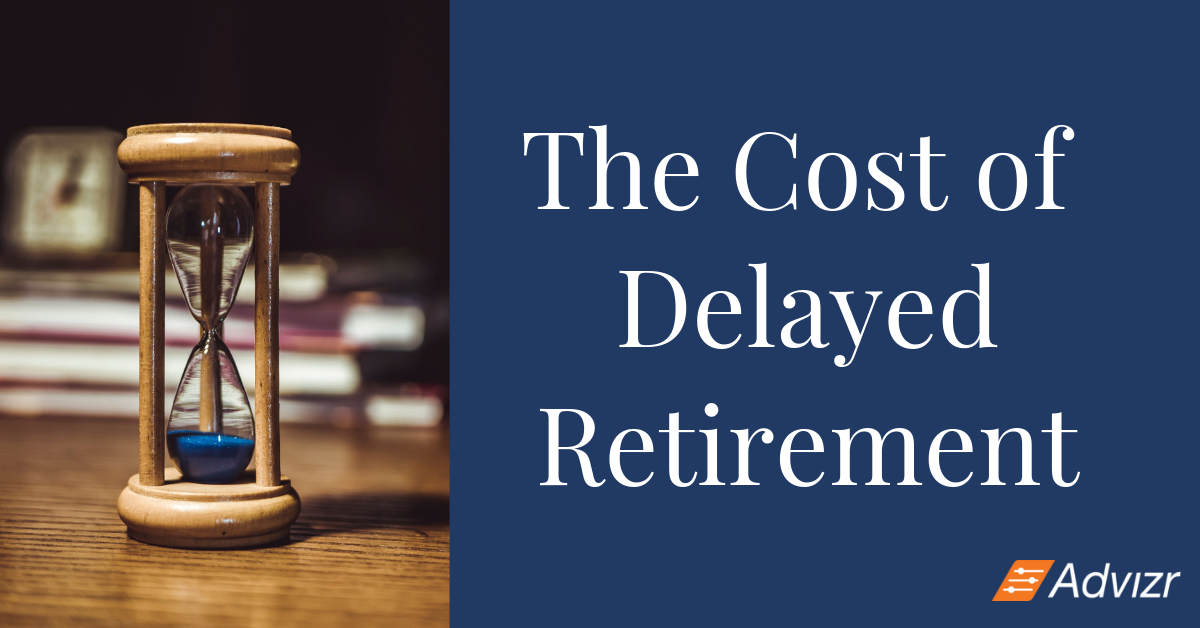
17 May The Cost of Delayed Retirement
Read this article to learn how delayed retirement effects employees and employers and how Human Resources and Management can assess the needs of their workforce using technology to proactively engage and prepare their workers to retire on time and reduce overall costs.
Experts estimate that we will need at least 70% – 90% of our pre-retirement income to maintain our standard of living. However, a recent estimate from U.S. Government Accountability Office estimates 48% of Americans age 55 and older have nothing in traditional retirement savings accounts1. This is not only a crisis for these unprepared members of the workforce but a tremendous cost to employers who are continuing to pay top dollar for senior talent, not to mention the inevitable burden on local, state and federal social services.

A recent report by the Fed Reserve suggests that the cost of delaying retirement by one year is $50,000 per employee2!
Obviously, there is a need for monitoring and taking proactive measures to adjust, not just the number of employees approaching retirement, but the degree to which an employer’s population is concerned about, and prepared for, this landmark event.

Pain Points for Prospective Retirees
Why is it imperative for employers to prepare for those employees who are nearing, or in, what is traditionally considered retirement age? Retirement can be an exhilarating way to cap one’s career off, but all too many workers in today’s market are not prepared for this next step, which inevitably leads to delayed retirement and higher overall staffing costs, as well as an increase in the percentage of an organizations’ workforce who are distracted over retirement and finances in general.
Just a few of the points that workers seeking retirement will need to consider including:
– Health Care: Prior to retirement, a decision about healthcare coverage and cost provisioning should be made, both for the worker and their spouse. Growing healthcare costs and increasingly undependable longterm care insurance means preparation in this area is an absolute necessity.
– Medicare, Social Security, and Other Benefits: There are a number of tax-driven programs that workers need to research, apply for and, in some cases, make key decisions about how to implement or use.
– Life Insurance: Before retirement, the relative merits of life insurance and coverage needs should be considered. Additionally, employees will have to be apprised of the loss of any group coverage they may only be entitled to while on the payroll.
– Distribution Phase & Sequence of Returns: This includes optimizing overall benefits to a retiree based on when, how and in what order their retirement and investment accounts are accessed and subsequently drawn down. This will include weighty topics, such as tax penalties, rates of appreciation & growth and timelines and possible penalties related to accessibility.
– Goal / Life Planning: Retirement is a huge step and a surprising number of aging workers respond they have no clear cut plan related to their lives in retirement and only 10% are estimated to have a written plan for retirement.
Clearly, employers need to stay informed on how such financial stress is impacting their workforce over a period of time to understand the magnitude of improved performance.
How to Prepare for Employees Nearing Retirement
Investing the time it takes now to assess the needs and pain points of a workforce allows for segmentation across multiple criteria. This is what that process looks like:
1. Engage
The first step in this process is reaching out to the workforce in a scalable manner designed to be quick and easy. This includes providing best practices for the employer while ensuring a high level of employee participation. In this day and age, that means mobile-ready technology and seamless execution that can be catered to the specific needs of the individual.
The manner in which a workforce is engaged is foundational, as it sets the tone for a continuing, iterative process.
2. Measure
Now that clients have been engaged, their responses can be gathered, analyzed and used as a benchmark. This need not be an invasive process as the data can be anonymous and aggregated, fed into an informative executive-level dashboard.
This process furnishes the organization with a wealth of information about the concerns their workers face and the challenges their organization must confront. The possibilities are manifest, but focusing on retirement, the number of factors easily pulled out from this data include the number of affected individuals, what generation they fall within and to what degree they are impacted.
3. Action
When the degree and types of needs specific to the workforce are established, the next step must be actively engaging the workforce in a substantive way that is easy and meaningful to their goals. Using technology to address the problems that are preoccupying an employee the most, record those goals and their current state, while keeping the process simple and intuitive is key. What’s more, giving meaningful options and feedback related to progress on their goals encourages them, keeps them coming back and builds those positive behaviors.
An Evolving Proposition
FinWellTech is in an exciting phase, where technology has finally evolved to provide a personalized, scalable solution that connects the disparate pieces of employees’ lives (i.e. their concerns, goals, financial situation, far-flung account data), and ties them together with an actionable financial plan. All this, while incrementally measuring and reporting on the return on investment.
To learn more about how Advizr WorkPlace is using technology to solve for financial wellness needs, sample our free employee assessment tool.
1 U.S. Government Accountability Office Report https://www.gao.gov/products/GAO-19-442R
2 Prudential, Why Employers Should Care About the Cost of Delayed Retirements http://research.prudential.com/documents/rp/SI20_Final_ADA_Cost-of-Delayed_1-4-17.pdf
Graphic 2: PwC US, 2018 Employee Financial Wellness Survey.
https://www.pwc.com/us/en/industries/private-company-services/library/financial-well-being-retirement-survey.html
